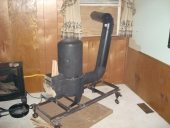








Jared Mevissen wrote:So I have not read the book yet, basically just went from lots of diff forum posts and vids and got the gist of it. I wanted to try it out before it got hot "which I accomplished" got this finished and tested outdoors about a week before the snow was gone. I still have not tested it in my workshop but I have to do some leveling etc in there before I can install it so will not be able to do that until next fall anyhow, but at least I know it "works".
...
I am sure I may have screwed up a few things, especially the heat riser. I want to read up and redo that because I don't think it is void of voids. But it does seem to work so I dunno, maybe its ok.




Len Ovens wrote:
Jared Mevissen wrote:So I have not read the book yet, basically just went from lots of diff forum posts and vids and got the gist of it. I wanted to try it out before it got hot "which I accomplished" got this finished and tested outdoors about a week before the snow was gone. I still have not tested it in my workshop but I have to do some leveling etc in there before I can install it so will not be able to do that until next fall anyhow, but at least I know it "works".
...
I am sure I may have screwed up a few things, especially the heat riser. I want to read up and redo that because I don't think it is void of voids. But it does seem to work so I dunno, maybe its ok.
Seems a bit cool, my top gets 200-250C But then I did have a bigger fire and was into about 2 hours of burn. From what I saw your riser looks ok. I can't tell what your head space is from the vid. Should be just under 2inchs. The gas close to the walls doesn't move as fast as the gas in the center. The temp measured on the barrel walls and flue pipe are lower than the temp in the center of the flue gas stream... That is why there is still heat to extract with a bench.
Not sure what to make of the feed. I thought of doing it that way too, but decided to use an upside down T instead. It gives me a "clean out" too.




Jared Mevissen wrote:
I never even really thought about using a T, in retrospect it would be nice however clean out does not appear to be a problem it might be if I was running it for an extended burn "hours at a time" and the buildup in the burn/feed area became to much to the point that it would restrict airflow. But I kinda doubt it and I hope not to have to run it that much. This one or the one I build after this one will be for heating a workshop that is only used once in a while. Another thing with a T I would have to have it come out the side in this design unless I planned on having this up off the floor which I am currently not. "Actually contemplating setting it in the earth floor and doing the floor as the mass assuming I would have to insulate under the mass if I did that however"
As far as the head space goes I never even measured, I did read a part in the book that said that as long as it was under 12" it was fine..... ok so I just went and re-read that part in the book, I must have misread it and or looked at the diagram wrong so I am assuming my heat riser is not high enough but will have to measure.
So at this point my main concerns are the riser, and possibly the exhaust exit on the back of the barrel in a standard rmh this area seems to be wider than 6" however the gasses are dropping down, so by going straight out the back of the barrel with the 6" opening is this big enough?
So I just looked up the Height of a 30 gallon barrel I get a inside Height of 27.5 so being that my riser is made of 2' stove pipe "I believe its 2' have to measure to be sure that would mean I have a space of 3.5" + or - a bit considering now I have the gasket under the barrel and just my barrel may be diff than the one I Have looked up. So it says here in the book it should be 2-3" for an 8" system and 1 1/2 to 2" for a 6" so I am probably off by a ways so by being more than the recommended distance how does that affect it? I mean in my tests it seemed to work especially my last test which would be the furthest away since I added the gasket under the barrel. I could hear the system "running" from 60 feet away
Oh ya and in my newest vid I could not measure the heat on the top of the barrel my laser temp sensor stops at around 320f or so. So its possibly it got up to the same temps as yours I just don't know, don't have anything to measure that with currently. Also my longest burn has maybe been half an hour of decent fire probably not even that long.

|
Blueberry pie is best when it is firm and you can hold in your hand. Smell it. And smell this tiny ad:
The new permaculture playing cards kickstarter is now live!
https://www.kickstarter.com/projects/paulwheaton/garden-cards
|








